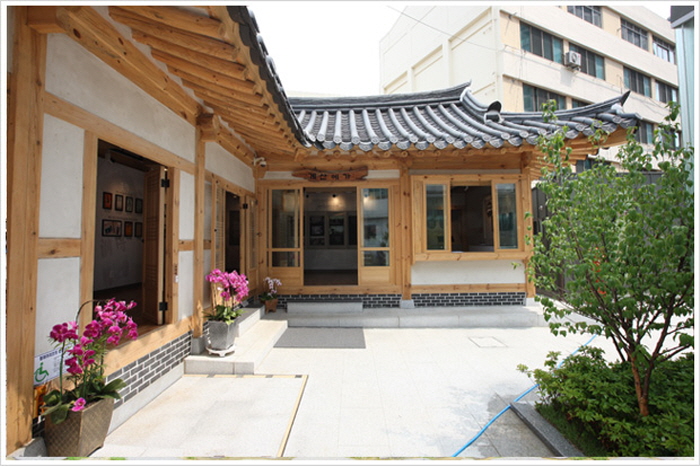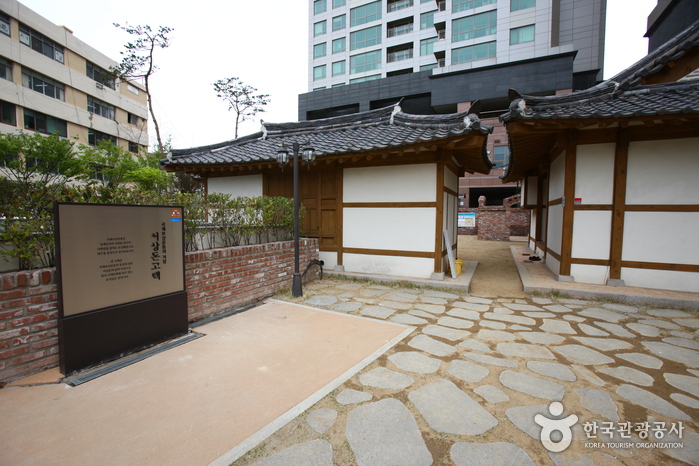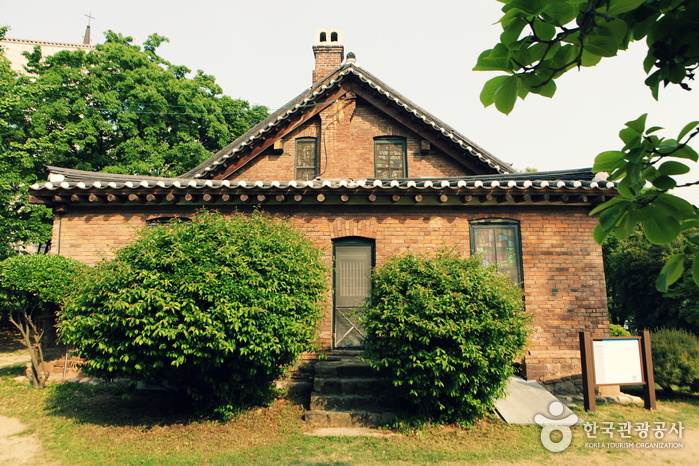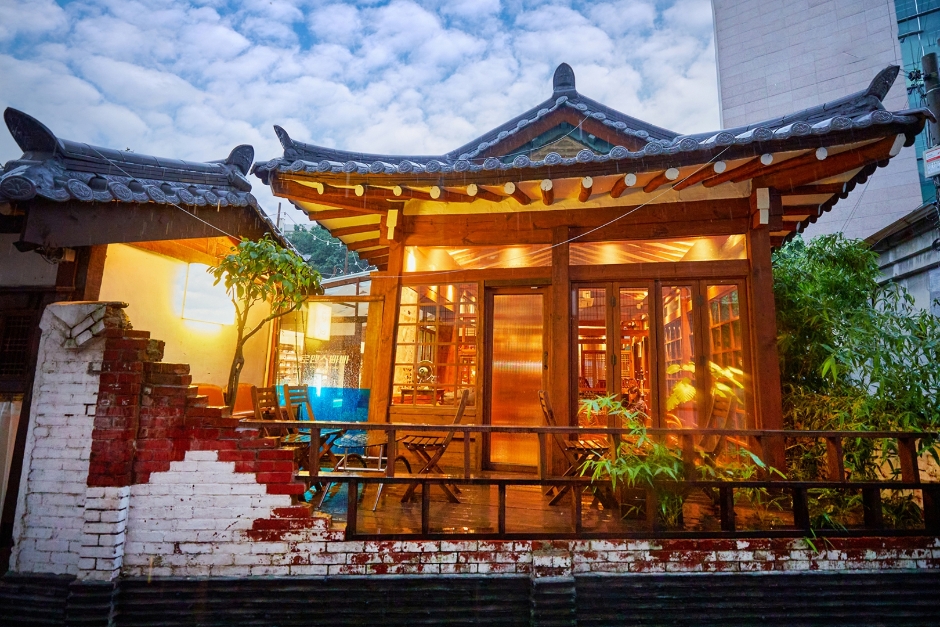Modern History Experience Hall Gyesanyega (근대문화체험관 계산예가)
3.5Km 2021-04-27
6-1, Seoseong-ro, Jung-gu, Daegu
+82-53-661-3323
Modern History Experience Hall Gyesanyega opened in 2012 is a public space designed for rest and education. Visitors can enjoy a moment of relaxation while touring Daegu Modern Culture Alley, as well as learn more about the history of the area through the video hall and about the houses featured along the way, such as House of Yi Sang-hwa and House of Seo Sang-don, at the hanok exhibition hall.
House of Seo Sang-don (서상돈 고택)
3.5Km 2021-07-01
6-1, Seoseong-ro, Jung-gu, Daegu
+82-53-256-3762
The house of entrepreneur and activist Seo Sang-don is located in the heart of Daegu. In 1907, in an effort to repay national debt and to gain independence from Japan, Seo launched the National Debt Repayment Movement as well as a nationwide campaign calling for people to quit smoking.
In celebration of Seo's leadership, the City of Daegu restored Seo's old house and opened it to the public. The City also built the National Debt Repayment Park and erected a statue of Seo in his honor.
March 1st Independence Movement Road (3·1만세운동길)
3.6Km 2023-01-20
Dongsan-dong, Jung-gu, Daegu
March 1st Independence Movement Road is a historical location where Daegu citizens gathered for the independence movement on March 8, 1919, and the midpoint of Daegu Modern Alley Tour Course 2. Passing Cheongna Hill Missionary's House and Jeil Church, you will come to a road with murals of the independence movement. The March 1st Independence Movement Road is a hilly road leading to Gyesan Cathedral. It is also called 90 Stairs because there are 90 steps. On the wall of the stairs, there is an augmented reality (AR) experience zone along with site photos from history. By scanning the QR code is a 3D video that vividly reproduces the independence movement, enabling a realistic experience of history. Follow the signs of the Daegu March 8th Independence Movement marching road to reach the main road and it will lead to the the 100th anniversary monument of the March 1st Movement and the starting point of the March 8 Movement. A guided alley tour is available for free with an online reservation on the official website.
Olive Young - Daegu Chimsan Branch [Tax Refund Shop] (올리브영 대구침산)
3.6Km 2024-04-17
124, Chimsan-ro, Buk-gu, Daegu
-
E-Mart - Chilseong Branch [Tax Refund Shop] (이마트 칠성)
3.6Km 2024-04-23
93, Chimsan-ro, Buk-gu, Daegu
-
Dongsan Cheongna Hill (동산청라언덕)
3.7Km 2025-10-24
2029 Dalgubeol-daero, Jung-gu, Daegu
+82-53-627-1337
Cheongna Hill is the place where Christian missionaries resided during the early 20 century, planting many ivies along the site. It is also called Dongsan Cheongna Hill for being on the eastern side of Daegu's center. There are many attractions in this beautiful garden including Chamness’ House, Switzer’s House, Blair’s House, 90 stairs, Daegu 3.1 Independence Movement Road, Daegu's first western apple tree, a memorial stone inscribed with the song "Thinking of My Friend” , and the cemetery of the missionaries and their family. Cheongna Hill is also the starting point of Daegu's Street Tour Course 2 as well as a popular drama film location.
House of Missionary Switze (선교사스윗즈주택)
3.7Km 2024-08-05
2029 Dalgubeol-daero, Jung-gu, Daegu
The House of Missionary Switze served as home for a host of American missionaries. Built between 1906 and 1910, the home is a Western-style structure with two above-ground floors and one basement level. In 1981, the house was used as company housing for doctors at the nearby Dongsan Hospital, at which point changes were made to the interior and exterior of the house. It was later changed into a missionary museum, displaying items used by the missionaries who lived in.
Hanok 1957 (한옥1957)
3.7Km 2024-12-13
20-2 , Gukchaebosang-ro 101-gil, Jung-gu, Daegu
+82-53-214-1957
Located downtown Daegu, Hanok 1957 is a traditional Korean hanok built with red pine and woven with clay and straw roof tiles. The rafters, beams, and cabinets inlaid with mother-of-pearl add comfort and tranquility to the interior. There are five guest rooms, all of which are ondol (underfloor heated) rooms with bathrooms. There is a shared kitchen where you can cook simple meals. Seomun Market Station and Daegu Station are within walking distance, and nearby attractions include Dalseong Park and Seomun Market are also nearby.
Romance Papa (로맨스빠빠)
3.7Km 2024-04-01
492-6 Gukchaebosang-ro, Jung-gu, Daegu
This cafe is located near Seomun Market and Seomun Market Station on Daegu Subway Line 3. It is a hanok renovated with a retro and classic interior. Wooden doors and mother-of-pearl shelves between the seats create an atmosphere of warmth and relaxation, as if visiting a Korean grandmother's house. There are also seats in the yard where one can have coffee and dessert while enjoying the unique atmosphere of a hanok. The place has drinks and desserts made with various fruits and pour-over coffee. The signature menu here is called Perpetual Snow. It's similar to Einspänner, but it's topped with its own unique cream, so it's nutty and sweet. Visitors can also enjoy ade and smoothies with peach pulp in the summer.
House of Missionary Chamness (선교사챔니스주택)
3.7Km 2022-09-06
2029, Dalgubeol-daero, Jung-gu, Daegu
+82-53-661-2193
House of Missionary Chamness was the home of American Christian missionary Chamness and his family. It was built in the Western-style and provides a glimpse into the daily life of American missionaries in Korea. The house, a simple building in comparison with the houses of America at the time, is now considered a very important treasure of Korea's modern history. The building has been converted into a small museum using artifacts from the missionaries to bring the past to life.


![Olive Young - Daegu Chimsan Branch [Tax Refund Shop] (올리브영 대구침산)](http://tong.visitkorea.or.kr/cms/resource/36/2888036_image2_1.jpg)
![E-Mart - Chilseong Branch [Tax Refund Shop] (이마트 칠성)](http://tong.visitkorea.or.kr/cms/resource/99/2888199_image2_1.jpg)




 English
English
 한국어
한국어 日本語
日本語 中文(简体)
中文(简体) Deutsch
Deutsch Français
Français Español
Español Русский
Русский